- Our Mission

Exploring Argument Writing With Visual Tools
Teachers can have students use graphic organizers and timelines to clarify their thinking during the writing process.

As a teacher who loves to write and engage students with writing, I’ve experienced many challenges in attempting to bring composition into the classroom. While some students readily fill up blank pages with words inspired by their lives and stories they love, others are seemingly always in search of the best words.
More challenging still are those moments when I’ve led students through the steps necessary for expository and research-based argument writing. I’ve found that my students who are comfortable with the narrative mode are now thrust into compositing in a way that is unfamiliar ground.
This article explores some ways I’ve applied graphic organizers and visual planning strategies to the work of argument writing—which is perhaps the mode I consider the most challenging in the classroom.
Sifting Content
First among the challenges for argument is the way that debate and disagreement are often portrayed in popular culture—shouting matches and interruption rounds where it seems that the loudest voice wins out. In my classroom, the approach that I attempt to foster for argument is one of thoughtful intention and wisely applied rhetorical strategies.
As with much of the secondary curriculum I have worked with from middle-grades English to advanced composition, sorting information into categories (ethos/ethics, logos/logic, and emotion/pathos) is a helpful step once a topic is shared and resources are gathered.
But sorting through multiple paragraphs and pages in search of the “just right” evidence can be challenging and is a critical reading practice all on its own. To support these steps in criticality, I suggest that students create a simple three-column chart in which they can begin to sort the emotional, logical, and ethics-driven elements of their argument. Using a visual scaffold to support exploration of a complex reading is an essential step for me—and I used a similar strategy just this past week in my junior-level English class to sort out ideas and compare the writings of Thomas Hobbes and John Locke.
By sorting ideas in this way, students can physically see how balanced their argument actually is, and they can begin thinking about what they need to ramp up for the eventual presentation of the case.
Gathering Further Ideas
Another challenge in composing arguments is not only sorting and interpreting information, but also applying it in a way that includes informative and persuasive techniques.
As students consider the ways to apply these skills, they can begin to think through additional sources that they can use to build their foundation for thinking about the issues they’re presenting and noting the sources that help them build the strongest case. This type of exploring and writing is especially important when practicing synthesizing ideas across multiple sources.
On the surface, this process sounds like reading and rereading multiple sources (and it is). However, I apply a visual scaffold to this process to help students think about how their resources are linked and support or contradict each other. I illustrate the claim, counterclaim, and rebuttal aspects of argument structure through a visual outline, but the work of fleshing out these sections of the discussion takes place best in a mind map structure.
A simple three-circle Venn diagram can help students begin placing ideas into the claim section, and they can explore how authors overlap ideas with one another through this graphic organizer format. Ideally, they reach a point where the strongest ideas are in the center “target” point of the argument structure. They can think about best placement of these strongest ideas as leading points or final rebuttals—depending on what they want to leave their audience with. This approach is also helpful for relieving some of the stress that can surround framing what might be a challenging and less comfortable form of writing.
The additional details they gather can then be sorted further into areas of the argument structure that make sense.
Establishing Timelines
Further adapting the outline style, I encourage students to think about the argument as a timeline wherein their audience is most likely to connect with information early and remember information late. Outlining is almost always a building block of what I ask students to engage with when composing. For debates and discussions in our class, writing a timeline is an effective process.
From this timeline (prompting discussion and exploration of evidence and argument), students can practice writing their own arguments and responses by modifying it and including aspects of evidence and ideas they want to share (in whatever particular order they'd like to present their research).
Crafting Closing Arguments
By approaching an argument step-by-step, as discussion and collaboration that improves through a process, I have the goal of making what might seem complicated and overwhelming much more attainable and inviting—even, dare I say, active and interesting.
I recognize that many of my students might not have had vast experiences with all of the modes of writing and composing, and I take into account that some will be more naturally inclined to some ways of writing and sharing than others. Some students eagerly take the lead in an oral debate process, while others more readily engage in the research roles and independent writing components of the work.
As with much of my work in literacy, I attempt to make an invisible process clear and visual—in this case, through graphic organizers. I am aware that teachers might find other graphic organizer options that work more effectively at particular aspects of the argument process. For example, the Venn diagram might not communicate in the ways that a teacher may want, and so a flow chart/mind map or T-chart might work as a better substitute.
I encourage teachers to modify any steps in order to better support their students and focus on the importance of critical thinking and composing for all students.

How to Use Graphic Organizers to Write Better Essays
Lucid Content
Reading time: about 6 min
If you’re a student, there’s no way around the inevitable: You’re going to have to write essays. Lots of essays. In fact, the five-paragraph essay is so fundamental to the high school curriculum that it’s still used on the ACTs, and knowing how to recognize the organizational structure of essays will help you score higher on the SATs.
Even though it seems like a chore, knowing how to organize and write an essay can have a lasting effect on your life, from getting into a better college to scoring a better job to performing better in that job long after your high school days are over.
Here’s a secret: Using graphic organizers for writing essays can help you write better essays faster. (And don’t count yourself out if you’re an educator—you can offer these tools to help your students succeed.) We’ll show you exactly how to do it.
Why use graphic organizers
When ACT graders or teachers are looking your essay, they’re looking for very specific criteria; essentially, they’re looking at how well you’ve organized your thoughts. Many students don’t take the time to outline their essay structure before writing, and that always means a lower score on a test and a lower grade on the essay in class.
Using a writing template can feel like an unnecessary step in an already complicated process. If you need extra motivation to implement these organizers into your writing routine, consider all of their benefits. Graphic organizers can help you:
- Save time by showing you where each piece of the essay “lives.”
- Have more productive brainstorming sessions, either by yourself or with a group.
- Make connections between ideas and create a more cohesive argument.
- Pinpoint holes in your arguments and either adjust the thesis or find supporting statements.
- Keep track of your research.
- Organize your thoughts and come to interesting, more compelling conclusions.
- Stay in the right direction when you feel lost in a sea of words.
- Manage anxiety by converting the fear of a blank assignment into an action plan with a clear map.
With all those benefits, it’s hard to ignore how useful and vital graphic organizers are to writing. And once you’ve become adept at organizing your thoughts for something like a school essay, you’ll find that skill carries with you throughout your life, whether you’re trying to become a more intelligent debater to negotiate prices. It goes beyond just the essay to becoming a better thinker. And it starts with a simple template.
We’ll walk you through several use cases for graphic organizers and provide templates for you to download and fill in when you’re ready to write.
Brainstorming graphic organizers
Brainstorming is important, not only to come up with ideas for topics but to determine what information you need to include in the essay once you’ve determined your topic. Though many think of brainstorming as just freeflow thinking, brainstorming is most productive when you work within specific parameters.
That’s why essay brainstorming graphic organizers are useful, whether you’re using one to brainstorm on your own or you’re working with a group.
In Lucidchart, our mind map shapes and templates double as brainstorming graphic organizers. Start with an essay prompt as your central shape and then fill in the shapes that branch off your prompt with topic ideas. Alternatively, you can add your selected topic to the center and start brainstorming the different ideas you need to cover in your paper.
When the template is filled in, you’ll have a clear starting point for your essay or research paper.
Research paper graphic organizers
Nothing paralyzes students with fear quite like a research paper. These long-form papers require—as the name implies—quite a bit of research, and their purpose is to teach students how to look for valid sources to support their arguments.
But keeping track of all those sources and tying them into your argument can be tricky. That’s where a research paper graphic organizer can be a student’s greatest ally.

This template lays out the writing process itself. After you come up with a general topic, like “the disappearance of honey bees,” fill in the “Research Paper Topic” box.
Then, start looking for reputable sources (Wikipedia doesn’t count) and use the five sources boxes to hold the most relevant quotes and statistics you find. Using those quotes and statistics, you can then fill out a thesis statement that is supported by the research.
Then, you’ll be able to focus your paragraphs on a single topic each that supports the thesis statement and your overarching argument. After you’ve filled out the template, the backbone of the research paper is complete: All that’s left to do is fill in the spaces between sources and arguments.
5-paragraph essay graphic organizer
When it comes to writing the five-paragraph essay, writing diagrams are key. By using graphic organizers for writing, you’re no longer staring at a giant blank piece of paper with no idea how or where to begin. Your graphic organizer is your map.
Although using writing diagrams may seem time-consuming, the fact is that taking the time to fill a graphic organizer in before writing actually saves time. If there’s a problem with the argument, it will show up on the diagram, or if there’s not enough evidence to support your argument, you’ll know before you’ve wasted time writing the paper. And, as we said before, even if your writing is terrible, if your argument is sound, you’ll still score a decent grade.
Try this 5-paragraph essay template to get you started.

Don’t feel pressured to come up with a compelling title right away. Instead, it’s more important that you come up with a thesis statement that can be supported by three solid arguments. Fill in that thesis statement and your arguments. Then, for each argument, figure out three supporting details to support your case.
That’s it! You’ve got the most essential parts of your 5-paragraph essay completed.
Now, come up with an introduction that sets the stage for your argument and a conclusion that wraps up and restates your thesis and supporting arguments in a compelling way. Now you have a solid plan for your paper and can approach it with confidence.
If you’d like a more linear graphic that exactly follows the structure of the 5-paragraph, use the writing template below and follow the same process.

Visuals, such as graphic organizers for writing, can help you better understand concepts, think creatively, and collaborate with your classmates—and there are plenty of other templates where these came from.
Lucidchart offers hundreds of templates to help you through your studies, including timelines, Venn diagrams, word maps, and more. Sign up for Lucidchart and upgrade to an Educational account for free.
Resources for teachers
Providing graphic resources to students is essential; after all, many of your students will be visual learners, so while you may beautifully explain how the process works, there will be some who won’t understand until they see a template of the essay itself.
Lucidchart has many resources for teachers, from lesson plans to writing templates. While you’re teaching your students how to write essays or research papers, it’s useful to print out the templates and fill them out together (even using a completed template as a separate assignment with a separate grade) so that your students can get a feel for properly filling out graphic organizers before attempting it on their own.
Lucidchart, a cloud-based intelligent diagramming application, is a core component of Lucid Software's Visual Collaboration Suite. This intuitive, cloud-based solution empowers teams to collaborate in real-time to build flowcharts, mockups, UML diagrams, customer journey maps, and more. Lucidchart propels teams forward to build the future faster. Lucid is proud to serve top businesses around the world, including customers such as Google, GE, and NBC Universal, and 99% of the Fortune 500. Lucid partners with industry leaders, including Google, Atlassian, and Microsoft. Since its founding, Lucid has received numerous awards for its products, business, and workplace culture. For more information, visit lucidchart.com.
Related articles

Check out how Annika, a recent English graduate of the University of Michigan, used mind mapping in Lucidchart to develop her honors thesis.
Bring your bright ideas to life.
or continue with
Persuasion Map
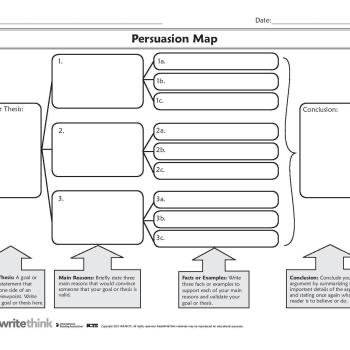
About this printout
Use this graphic organizer to develop a persuasive stance for an essay, speech, poster, or any type of assignment that incorporates persuasion.
Teaching with this printout
More ideas to try, related resources.
Examples of persuasion surround our lives, and the ability to persuade others is a powerful asset. We can persuade people to act in our favor, help them to see our point of view, and sway their opinion to that of our own. The power of persuasion is far reaching, and it is a technique that students will use throughout their lives. This tool helps students formulate ideas for a persuasive argument by helping them determine their goal or thesis, identify three reasons to support it (with three facts or examples to support each reason), and restate the thesis in a conclusion statement. Before your students use this tool independently, model its use for them. Choose a simple topic (such as, “Sixth Grade is the Best Grade” or “Why Our Lunch Period Should be Longer”). Then, fill in the Persuasion Map while discussing the process aloud, displaying the tool so that all students can see it. Review students’ completed maps prior to having them continue with the persuasion assignment. This will provide you with an opportunity to check students’ understanding of persuasion and help those who need extra instruction.
- Have students analyze a persuasive piece (for example, an advertisement or editorial in a newspaper or magazine) by filling in the map and discussing the authors’ strategies of persuasion.
- Encourage older students to create propaganda-based assignments by having them incorporate deceptive language in some of the “reasons” or “examples” on their maps. (Propaganda is a form of persuasion that uses deceptive language to exaggerate, distort, or conceal information.) Upon completion, have students read their maps orally and/or display them for their peers. Have students identify the deceptive language in their peers’ maps to create a class list of the examples used. As an additional follow-up, students can view and read advertisements, newspaper editorials, and other text that contain propaganda to search for use of the examples on the class list and to add additional ones.
- Have students complete two maps based on the same goal but with two different targeted audiences in mind. Attention to audience is an essential element of effective persuasion. For example, students might create maps to market a particular children’s toy; one map could target children as the audience, and the other could focus on parents as the audience. After they have completed their maps, have students read them to the class without identifying the intended audience. Ask the rest of the class to determine the intended audience and identify the specific clues that prompted their deductions. Finally, as a class, compare and contrast the language and words used for each intended audience.
- Lesson Plans
- Student Interactives
- Strategy Guides
Through a classroom game and resource handouts, students learn about the techniques used in persuasive oral arguments and apply them to independent persuasive writing activities.
The Persuasion Map is an interactive graphic organizer that enables students to map out their arguments for a persuasive essay or debate.
- Print this resource
Explore Resources by Grade
- Kindergarten K
- Try for free
Argumentative Writing - Basic, Intermediate & Advanced Outlines
All three can be used in the same class--with either you assigning different organizers to different students per their needs, or students choosing an outline for themselves. Use these as a checkpoint in writing, or as an assessment for student understanding of each argumentative element.
Basic Outline: Use this essay outline template for students who either do not need much support in writing a comprehensive argumentative essay and need only to jot down ideas, or students who should just focus on Claim-Reason-Evidence for this round as a scaffolded step. The claim should be an opinion or something that other people could reasonably disagree with. Reasons should each be different ideas that supports their claim, and evidence should be facts -- either found through research or commonly known.
Intermediate Outline: This outline is similar to the Basic outline, but pushes students to explain what their evidence proves or suggests (reasoning). It also pushes them one step further to preview their points in their claim. Use this outline for students who need to organize their thinking and improve flow in their argument, or for students to brainstorm and outline their essay. It can also be used for ELL students, as the sentence stems can be very helpful in constructing their sentences. This outline is also especially useful for students who are struggling to add reasoning to their writing.
Advanced Outline: This is an outline for more advanced students who could benefit from the push to add more evidence for each reason and more thoroughly explain how their evidence supports their claim. It also includes a paragraph for the counterargument, which you could have students teach themselves from this outline or include as part of your counterargument lesson.


Featured Middle School Resources
Related Resources
About the author.

TeacherVision Editorial Staff
The TeacherVision editorial team is comprised of teachers, experts, and content professionals dedicated to bringing you the most accurate and relevant information in the teaching space.


Support Argumentative Writing and Classroom Debate with Organizers

Argumentative Writing is Hard
Creating and responding to cogent arguments requires that students take a position and that they understand the limitations of their own perspective. An accumulation of research on this topic has demonstrated that it is difficult for secondary students to consider multiple perspectives simultaneously while navigating complex topics in classroom debate or while producing argumentative writing. Recently, Karen Taylor (lead author, UC Irvine), Carol Connor (UC Irvine), Catherine Snow (Harvard University), and Reading Ways founder Josh Lawrence have published a paper that examines the cognitive and linguistic features of adolescent argumentative writing. We analyzed the persuasive writing essays of 40 middle school students who were participating in the Word Generation program , which supports student academic language through classroom discussion and debate. In each sample, students needed to take a position on a social issue, such as the use of nuclear power or whether the death penalty is justifiable. Each clause in these essays was coded as presenting one of four categories of argumentation, listed below:

Connectives: An Important Class of Academic Word
Karen also tallied the number of connectives used in the essays. Connectives are a kind of general academic word that helps to connect ideas. For instance, adversative connectives signal that two statements contradict each other ( alternatively, although ). Additive connectives are used to signal that two statements are similar ( again, further ). Causal connectives signal that one thing leads to another ( hence, since ). In a series of multiple regression analyses, we found a connection between students' use of these words and the level of their argumentation. These results suggest that if we want students to do advanced argumentative thinking, they need specialized words to do so.
Graphic Organizer For Argumentative Writing
Reading Ways has created two graphic organizers that provide both conceptual and linguistic support for students' argumentative writing (in collaboration with the Understanding Teachers as Designers project at the University of Oslo). In the first section of this organizer, students develop their own arguments and consider counter-arguments. In the next section, they consider opposing arguments and prepare rebuttals.

On the second page, students respond in writing. They’re given a list of adversative connectives, additive connectives, and causal connectives at the top of the page so that they might more easily access them for use in their argumentative writing.

Rebuttal Battle: Putting the Critical in Critical Thinking
A second organizer is focused on preparing students for a classroom debate. It helps them consider their side of the issue, the opposing side of the issue, and rebuttals that each side might make.

Icons help students keep track of positions, arguments, and rebuttals. One of our core interests is understanding teachers as designers. We know that most teachers will want to adapt these organizers to fit their particular needs, so we made them available both in both Word and PDF at the links below.
Argumentation Organizer
https://learningways.org/resources/argumentation-sheet.680251/
Rebuttal Battle
https://learningways.org/resources/680259/
For more information, see Taylor, K. S., Lawrence, J. F., Connor, C. M., & Snow, C. E. (2018). Cognitive and linguistic features of adolescent argumentative writing: Do connectives signal more complex reasoning? Reading and Writing . https://doi.org/10.1007/s11145-018-9898-6
Special thanks to Jenny Michelle Hughes Thorbjørnsen at the Understanding Teachers as Designers project at the University of Oslo; Deanna Kuhn at Teachers College for her scholarship on argumentation; my collaborators Karen Taylor, Carol Connor, Catherine Snow; the Strategic Educational Research Partnership and the Institute of Education Sciences; the U.S. Department of Education, which supported this research through Grant R305A090555 (Catherine Snow, Principal Investigator) to the Strategic Education Research Partnership (SERP), and through Grant R305F100026, awarded to SERP as part of the Reading for Understanding Research Initiative.
Stay Up to Date
Get notified when a new blog post is published.

Persuasive Writing Graphic Organizers

These free persuasive writing graphic organizers will help your fourth, fifth and sixth grade writers plan their writing during writing workshop.
You can use these persuasive writing graphic organizers to help your students organize and plan their writing.
These eight printable pages will help you in planning for student writing.
This is another free resource for teachers and families from The Curriculum Corner.
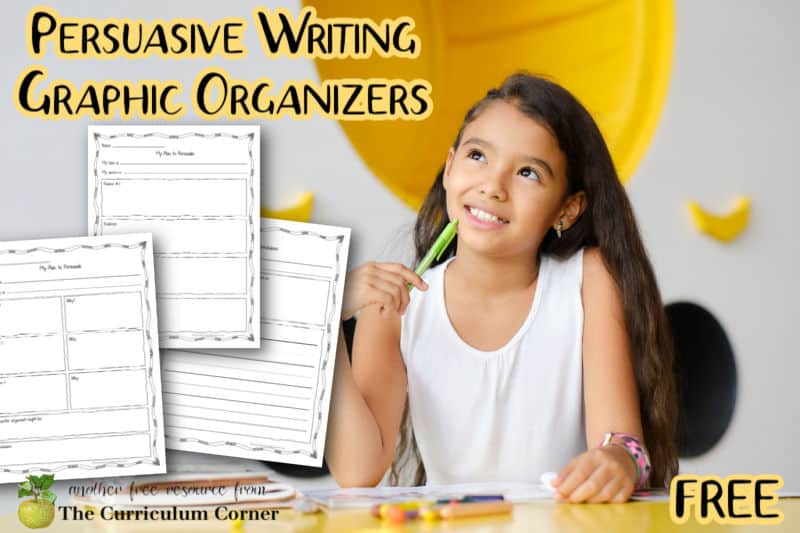
Using graphic organizers during writing workshop
Looking for new pages to help your students plan their writing? These are a great place to start!
These graphic organizers are designed to help your students organize their thoughts and research.
Beginning a writing piece by completing one of these pages will make the writing process a little bit easier for your students.
Use these graphic organizers to get started with their opinion writing. Choose the one that fits the given task or the one that meets the needs of each student.
There are a variety of pages for you to choose from. You can either pick the organizer that fits the writing process your students will be using or let students choose.
Sometimes the choice is key to motivating writers. Other times, it can be helpful to plan your instruction around a specific organizer. Do what you believe will be the best fit for your class!
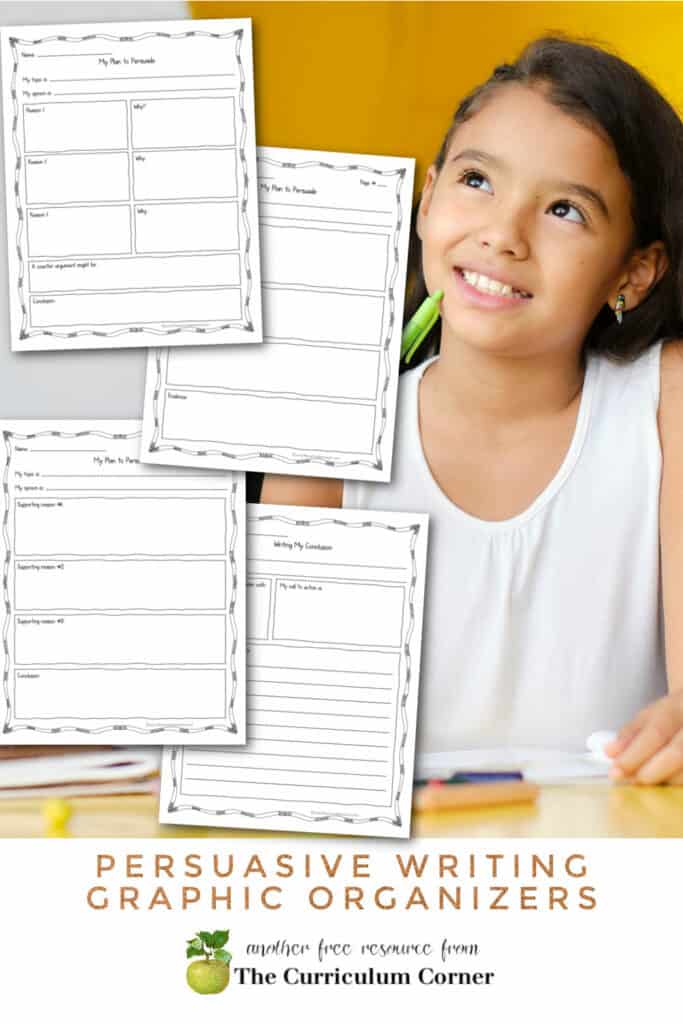
About these persuasive writing graphic organizers
This collection contains eight pages.
Along with a spot for students to identify their topic and then opinion of the topic, there are places for students to begin their planning.
Students will share their reasons for their opinions on some pages.
Part of persuasive writing is citing evidence to support student opinions. Encourage students to add notes about what their research teaches them.
One of the provided pages can be used for students creating a longer research pieces. Look for the organizer that says page#: at the top right. Students can use one page for each paragraph they are planning. Along with sharing their reason, they will record three pieces of evidence to support their opinion.
You might choose to also add one of the two provided conclusion organizers to student planning.
You can download this complete set of graphic organizers for writing here:
Writing Download
Looking for other writing resources? Try these freebies we have also created:
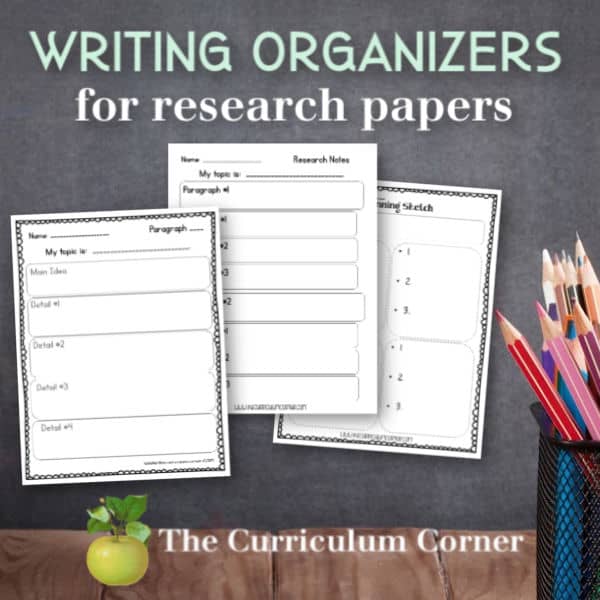
As with all of our resources, The Curriculum Corner creates these for free classroom use. Our products may not be sold. You may print and copy for your personal classroom use. These are also great for home school families!
You may not modify and resell in any form. Please let us know if you have any questions.
Opinion Writing Unit of Study - The Curriculum Corner 4-5-6
Sunday 18th of April 2021
[…] Persuasive Writing Graphic Organizers […]
Compare and Contrast Activity - The Curriculum Corner 4-5-6
Sunday 11th of April 2021
[…] « Persuasive Writing Graphic Organizers […]
Argumentative Essay Writing - Rubric - Graphic Organizer - Is Homework Effective

- Google Apps™
Also included in
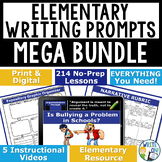
Description
Introducing how to write an argumentative essay has never been easier! This argument writing prompt lesson guides students through a step-by-step process of writing an opinion essay. It includes an argumentative graphic organizer , rubric, argumentative writing quiz, and an argumentative writing outline . The topic of this resource is - Is Homework Effective?
All aspects of argument writing are covered in this resource: brainstorming ideas , developing a thesis statement , introducing supporting evidence , writing hooks and leads , and incorporating the 6 Traits of Writing ™.
The video, slide show, graphic organizer, worksheets, writing template, and rubric allow students to practice and develop their argumentative writing skills. The writing quiz reinforces guided note-taking techniques when used in conjunction with the instructional video. The detailed lesson plans make implementing argument writing easy for teachers.
The lesson can be used in class, assigned for distance learning, or given as independent student work. The instructional video with writing tutorial and template can also be presented as whole class instruction or assigned for students to complete at home.
Each resource listed below is included in Google Drive™ and print format.
*****************************************************************************************
This Argumentative / Argument Essay Writing Prompt lesson includes:
Entertaining Instructional Video with:
- Description of argumentative essay
- Requirements of argumentative writing
- Brainstorming ideas
- Prompt identification and comprehension
- Thesis statement development
- Rubric explanation
- How to Write an Argumentative Essay tutorial and writing template
- How to Write an Argumentative Essay writing quiz / guided note-taking
Detailed Lesson Plan with:
- Common Core State Standards indicated on lesson plan
- Instructional Focus
- Instructional Procedures
- Objectives/Goals
- Direct Instruction
- Guided Practice
- Differentiation
- ESE Strategies
- ELL Strategies
- I Can Statement
- Essential Question
Argumentative Writing Worksheets with:
- Brainstorming section
Slide Show Presentation with:
- Introduction slide with prompt (interactive for students to identify key vocabulary)
- Brainstorming slide (interactive for students to list ideas)
- Standard and implied thesis development slides
- How to Write an Argumentative Essay tutorial and writing template slides
- Checklist slide
Argumentative Writing Quiz
Argumentative Rubric
Argumentative Graphic Organizer
Google Slides ™
The lessons in the Elementary Argumentative Writing Prompts Unit 1 include:
- What Time Should Students Go to Bed?
- Do Field Trips Help Students Learn?
- Do Kids Benefit from Gym Class?
- What Should Be a New Federal Holiday?
- Is Homework Effective?
- Should Parents Limit Screen Time?
- Are Sports Given Too Much Focus in Schools?
- Does TV Have Any Educational Value?
- Should School Uniforms Be Required?
- Do Video Games Promote Violence?
Connect with me for the latest Write On! with Jamie news:
- Write On! with Jamie Blog
- FB Community for 6-12 ELA Teachers
. . . and visit my WRITE ON! with Jamie website for a free TEXT EVIDENCE WRITING LESSON!
© Google Inc.™ All rights reserved. Google™ and the Google Logo are registered trademarks of Google Inc.™ Write On! with Jamie® is an independent company and is not affiliated with or endorsed by Google Inc.™
Terms of Use
Copyright © Write On! with Jamie. All rights reserved by author. All components of this product are to be used by the original downloader only. Copying for more than one teacher, classroom, department, school, or school system is prohibited unless additional licenses are purchased. This product may not be distributed or displayed digitally for public view. Failure to comply is a copyright infringement and a violation of the Digital Millennium Copyright Act (DMCA). Clipart and elements found in this product are copyrighted and cannot be extracted and used outside of this file without permission or license. Intended for classroom and personal use ONLY.
Questions & Answers
Write on with jamie.
- We're hiring
- Help & FAQ
- Privacy policy
- Student privacy
- Terms of service
- Tell us what you think

IMAGES
VIDEO
COMMENTS
The Persuasion Map is an interactive graphic organizer that enables students to map out their arguments for a persuasive essay or debate. Students begin by determining their goal or thesis. They then identify three reasons to support their argument, and three facts or examples to validate each reason. The map graphic in the upper right-hand ...
Exploring Argument Writing With Visual Tools. Teachers can have students use graphic organizers and timelines to clarify their thinking during the writing process. By Jason DeHart. January 4, 2024. Keith Alexander Lee / The iSpot. As a teacher who loves to write and engage students with writing, I've experienced many challenges in attempting ...
Guide your students' writing with this set of three multi-leveled argumentative writing graphic organizers. Use this essay outline template for students who either do not need much support in writing a comprehensive argumentative essay and need only to jot down ideas or students who should just focus on Claim-Reason-Evidence for this round as a scaffolded step.
Argumentative Essay Graphic Organizer Paragraph 1: INTRODUCTION Attention‐grabbing opening: Background of Issue: My position: (May include counter‐argument) Paragraph 2: Reason #1 Supporting Evidence: √ √ √ Paragraph 3: Reason #2 Supporting Evidence: √ √ √ Paragraph 4: Reason #3
Argumentative Writing: Graphic Organizer. As in any essay, the first paragraph of your argumentative essay should contain a brief explanation of your topic, some background information, and a thesis statement. In this case, your thesis will be a statement of your position on the issue. You are making a claim!
In Lucidchart, our mind map shapes and templates double as brainstorming graphic organizers. Start with an essay prompt as your central shape and then fill in the shapes that branch off your prompt with topic ideas. Alternatively, you can add your selected topic to the center and start brainstorming the different ideas you need to cover in your ...
Graphic Organizer for your Argument/Editorial Essay (OUTLINE) Directions: Below is a template outline to help you in structuring your ideas for your essay. This is due on Monday, Feb. 1st, 2016. This will be the first stage BEFORE typing. your rough draft. THIS IS NOT YOUR ROUGH DRAFT. (FYI: The typed rough draft is due. on Wednesday, Feb. 3rd).
When it comes to an overall structure for argumentative essays, you need to consider several things: • The claim you plan to make. • The arguments and evidence you have for that position. • The position your opposition holds. • The arguments and evidence your opposition has for that position. In the next few pages of this handout, you ...
The Persuasion Map is an interactive graphic organizer that enables students to map out their arguments for a persuasive essay or debate. Grades . 6 - 12 | ... This strategy guide focuses on persuasive writing and offers specific methods on how you can help your students use it to improve their critical writing and thinking skills. Grades ...
Use this graphic organizer to plan your analytical/persuasive essay. The introduction should start with a broad statement and end with your thesis statement, which "zooms in" on the points you will explore in more depth. The body paragraphs must contain evidence to support your thesis. (The number of body paragraphs coincides with the ...
Example: Graphic Organizer for the Argumentative Essay Support your claim Refute the objections Would banning of assault weapons reduce crime? The production, sale, and possession of assault weapons for private citizens should be banned in the U.S. Evidence Barbaric public slaying: − Columbine School Shootings
Graphic Organizers for Persuasive Essays and the Three Types of Persuasive Writing. There are three types of persuasive writing that our students will practice over their academic careers, but they probably don't realize that there are three different types. As our students learn, get older, and grow as writers we teach them opinion writing ...
Persuasive Writing Graphic Organizer -Paragraph #1 - Introduction Attention-grabbing beginning - Description of issue - Opinion Statement - Paragraph #2 Reason #1 - Evidence to support (details and examples) - - - - - - - Paragraph #3 Reason #2 -
Argumentative Writing - Basic, Intermediate & Advanced Outlines. All three can be used in the same class--with either you assigning different organizers to different students per their needs, or students choosing an outline for themselves. Use these as a checkpoint in writing, or as an assessment for student understanding of each argumentative ...
Persuasive Essay Graphic Organizer for Considering Stakeholders Stakeholders' Viewpoints . This activity is a shorter version of Gallagher's "Four-Sided Argument." (He teaches high school and has students write a page for each stakeholder; I work with middle school and have students bullet points for each stakeholder. ...
Graphic Organizer for a Toulmin argument How to use this organizer: This organizer is meant to be used for an argumentative essay. Before completing the blanks on the far right, you should have an argumentative thesis and an audience in mind for your essay. Also, you will want to think about whether or not your essay is suited to a Toulmin ...
Reading Ways has created two graphic organizers that provide both conceptual and linguistic support for students' argumentative writing (in collaboration with the Understanding Teachers as Designers project at the University of Oslo). In the first section of this organizer, students develop their own arguments and consider counter-arguments.
Persuasive writing graphic organizer are an invaluable tool for enhancing classroom instruction in persuasive writing. These visual aids serve as a roadmap for students as they guide them through the complex process of crafting convincing arguments. Teachers can introduce graphic organizers during persuasive writing lessons during the planning ...
You've found the perfect graphic organizer—complete with a fillable PDF option—to help students visually and clearly connect the integral elements of any persuasive, argumentative, and informative essay: from the claim, reasons, evidence, and conclusion, students can better organize and map out their thinking while understanding the general essay structure.
These graphic organizers are designed to help your students organize their thoughts and research. Beginning a writing piece by completing one of these pages will make the writing process a little bit easier for your students. Use these graphic organizers to get started with their opinion writing. Choose the one that fits the given task or the ...
Description. Introduce argumentative writing to all levels of learners with this comprehensive unit! Everything you need to differentiate and scaffold instruction is included with this printable and digital argument writing lesson! Use this bundle of step-by-step materials to guide students through every paragraph and element of argument writing.
Description. This activity is designed to help scaffold the argumentative or persuasive essay. Graphic organizers with writing checklists help students organize a five paragraph essay, with reminders to introduce a thesis statement, provide facts and examples, and introduce a counterclaim. De-mystify the argumentative essay once and for all!
Observations Organizer ... Pretend you are a graphic novelist. Create a 4-page mini-novel in which you defend the prompt. 5-paragraph essay Write a 5-paragraph essay that defends the prompt. The Persuasive Essay DIRECTIONS: Write a five-paragraph persuasive essay that defends this statement: World War I was the first modern war. Work to create ...
Persuasive essay graphic organizers are a great way to help scaffold the argumentative or persuasive essay. Graphic organizers with writing checklists help students organize a five paragraph essay, with reminders to introduce a thesis statement, provide facts and examples, and introduce a counterclaim. Also included is a sample argumentative ...
Products. $46.31 $522.83 Save $476.52. View Bundle. Argumentative Essay Writing Bundle - Rubric - Graphic Organizer - Outline - Quiz. Introducing how to write an argumentative essay has never been easier! This in-depth argument writing bundle with 10 prompt resources guides students through a step-by-step process of writing an opinion essay.